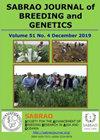大豆基因型的组合是通过三元杂交实现的
IF 1.7
Q3 PLANT SCIENCES
引用次数: 1
摘要
三元杂交是为提高大豆产量而进行的选育优良品种的人工杂交。本研究旨在评价大豆基因型单杂交和三杂交的成功率,以提高遗传物质基础群体的遗传变异性。遗传物质包括Grobogan、Anjasmoro和Dega-1三个大豆品种。三向交叉设计操作制作了各种各样的交叉。观察的参数为植株形态、杂交成功率、荚果内结实率、荚果内结实数和种子总重。结果表明,格罗博根×安佳斯莫罗杂交的成功率较高(57.14%),单粒和双粒荚果多,单株种子30粒,总重5.4 g。而三向杂交(F1血统[Grobogan × Anjasmoro] × Dega-1)的成功率中等(35.37%)。亲本三种基因型杂交的结果将在很大程度上决定大豆的变异性。本文章由计算机程序翻译,如有差异,请以英文原文为准。
ASSEMBLY OF SOYBEAN GENOTYPES DEVELOPED THROUGH THREE-WAY CROSS
A three-way cross is an artificial cross performed to assemble superior cultivars for increased soybean production. The presented study aims to evaluate the percentage of success in the single cross and three-way cross of soybean genotypes to enhance the genetic variability in the base population of the genetic material. The genetic material comprises three soybean cultivars, i.e., Grobogan, Anjasmoro, and Dega-1. The three-way cross design operation made various crosses. Parameters observed were plant morphology, percentage of cross success and seed formation in pods, number of seeds in pod, and the total seed weight. The results showed a relatively high (57.14%) success rate for the cross Grobogan × Anjasmoro, producing numerous one-seeded and two-seeded pods and 30 seeds per plant with a total weight of 5.4 g. However, the success rate in three-way cross (F1 descent [Grobogan × Anjasmoro] × Dega-1) was medium (35.37%). The results of crossing the three genotypes of parents will greatly determine soybean variability.
求助全文
通过发布文献求助,成功后即可免费获取论文全文。
去求助
来源期刊

Sabrao Journal of Breeding and Genetics
农林科学-奶制品与动物科学
CiteScore
1.90
自引率
50.00%
发文量
63
期刊介绍:
The SABRAO Journal of Breeding and Genetics is an international journal of plant breeding and genetics research and was first published in 1969. It is the official publication of the Society for the Advancement of Breeding Research in Asia and Oceania (SABRAO).
Its objectives are to: promote the international exchange of research information on plant breeding and genetics, by describing new research findings, or ideas of a basic or practical nature; and be a medium for the exchange of ideas and news regarding members of the Society.
The Journal gives priority to articles that are of direct relevance to plant breeders and with emphasis on the Asian region. Invited for publication are research articles, short communications, methods, reviews, commentaries, and opinion articles. Scientific contributions are refereed and edited to international standards.
The journal publishes articles for SABRAO members mainly. The Journal preferred strongly that at least one author should be a current member of the Society. Non-members may also publish in the journal.
 求助内容:
求助内容: 应助结果提醒方式:
应助结果提醒方式:


